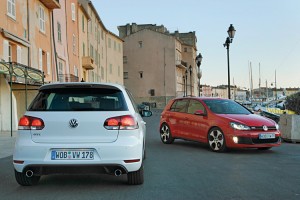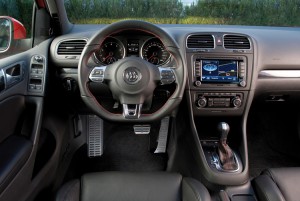
Six generations later, Golf remains VW's best seller.
It takes a certain confidence to use the word “momentum” if you’re an automaker these days. However, that’s precisely what Stefan Jacoby, CEO of VW of America, did as he introduced the Golf, aka Rabbit, aka Golf, aka Rabbit, in New York. In his view, Volkswagen Group’s record sales and $1.8 billion in profits in 2008 makes “momentum” appropriate, even if sales went down in the loss-making U.S. to 223,128 total units, a decrease of 3.2% versus 2007.
The year 2009, when the sixth generation Golf appears, will be an entirely different matter. VW Group is projecting a loss for the first quarter and thinks even with the new compact that debuted at Paris last fall – its most popular selling car globally – production will decline 10%. The U.S. market is running at a 10 million annual rate, reflecting the worst economic collapse in a generation, and where VW has struggled for decades against higher quality Japanese makes. It’s telling about attitudes in the parent company that the new Golf debuts first in Europe, Africa, Asia and Australia before finally arriving here this autumn.
The Golf, though, is a bright spot, even though it is again suffering from VW’s latest reinvention of a reinvention of itself in the U.S. While Rabbit is an appropriate marketing moniker for easy going ‘mericans, it won’t do for the rest of the world where an auto purchase is a more serious financial matter. And apparently it won’t do in the U.S. — once again — as VW’s stated goal to “outperform” the industry as a whole and to gain additional share globally is hinged on universal marketing names.
As a relatively fuel efficient two- and four-door hatchback offered with an extremely efficient, if unfashionable, 2-liter turbocharged diesel engine that’s capable of 30 mpg in city driving, the Golf is the right car at the right time. The turbocharged, 200 horsepower GTI performance version comes with a six-speed manual transmission or on optional six-speed dual-clutch automatic. It provides some advertising sizzle, if not some high sales numbers.

Latest interior is as plush as the original was plain.
The Golf over the years has lost the crispness of the original, as it gained weight and luxury and options that made it a much bigger, more expensive car. The styling of the new one hints at the forgotten past by reverting — sort of– to the look of the original grille. However, the car is rounded and flared, with character lines added. Overall, as always, it’s a safe, mainstream design that is in keeping, on the subdued side, with all current Euro designs. This has worked well over the generations as Golf has sold 26 million units in 120 countries. Whether it’s enough to revitalize the U.S. is debatable.
Inside, the car is plush with chrome accents and leather seats. For those who still think of the Golf as an econobox should be dissuaded by the equipment offered, including automatic lane spacing control, as well as electronic chassis control or even “Park Assist,” which parallel parks the car. How all this stuff is packaged in various models and ultimately priced in the U.S. remains to be seen. Currently Golfs, err, Rabbits range from $16,000 to $18,000 in asking prices for base models, before adding numerous options or subtracting for generous incentives.
Last year VW announced an “ambitious” plan of selling 800,000 Volkswagens here in this country by 2018 as it abandoned Michigan and moved its North American headquarters to Herndon, Virginia. It also announced a $1 billion North American factory in Chattanooga, Tennessee, that will build a mid-size sedan in 2011– the first currency hedging U.S. plant since it closed the Rabbit factory in Pennsylvania in 1988 after a four year run of declining sales. The new car and the new plant have promise, but these are similar to promises that have been made before. With the upcoming new Jetta and Passat models, it remains to be seen if the mütze trick will work.

Mentions were made about the luxurious list of optional equipment on the Golf, including leather interiors, but this seems to be a European market equipment list. Has VW issued a statement about what options will be offered in the U.S.? In the Mk V golf (Rabbit) in the U.S., you can’t even get a leather-wrapped steering wheel unless you upgrade to the GTI.
James, I should have made it clearer than I did:
Inside, the car is plush with chrome accents and leather seats. For those who still think of the Golf as an econobox should be dissuaded by the equipment offered, including automatic lane spacing control, as well as electronic chassis control or even “Park Assist,” which parallel parks the car. How all this stuff is packaged in various models and ultimately priced in the U.S. remains to be seen.
VW has not released the details you are looking for; and you bring up the real marketing issue — here versus Europe — where customers view compacts as much more expensive cars than they are considered here, and are willing to pay higher prices. We will have to wait and see what is offered here and at what prices.